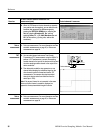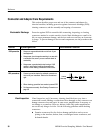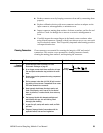
Reference
44
80E00 Electrical Sampling Modules User Manual
Figure 16: TDR step of undamaged sampling module
EOS (Electrical Overstress) Prevention
EOS occurs when an electronic device is subjected to an input voltage higher
than its designed maximum tolerable level. Similar to ESD (Electrical Static
Damage), EOS usually is also related to static charges generated by moving
elements. However, unlike ESD that typically deals with thousands of volts,
EOS can occur at a low voltage level. For Tektronix 80E00-series modules, EOS
damage could occur at levels as low as 10 V. EOS can have a cumulative effect;
repetitive EOS causes incremental damage over time and results in sampling
function deterioration.
Standard ESD precautions are not very effective for EOS damage prevention.
This is particularly true when the Device Under Test (DUT) is isolated from any
reference voltage levels, including the ground level. To prevent EOS damage of
80E00-series modules, strictly follow these EOS-prevention requirements:
H Observe all ESD prevention procedures.
H Before letting the probe tip touch the device under test, use a ground-
conducting element to discharge any residual charge at the test point.
H While measuring the DUT, make sure that no nearby personnel or objects are
moving. Moving personnel or objects can induce spurious charges on the
probe head. Such charges can easily reach levels of several hundred volts.
H For non-critical applications, proper usage of a static-isolation unit, such as
the Tektronix 80A02 EOS/ES D Protection Module, can safely discharge the
residual charges and protect the modules from EOS damages.
Prevention


















